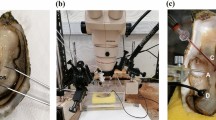Abstract
Salmonid fishes like the rainbow trout Oncorhynchus mykiss have a highly developed olfactory sense that allows them to perceive some odorants at very low concentrations, such as certain amino acids and bile salts. Previous behavioral and electrophysiological studies in salmonids have shown strong responses to human skin odor. Because this stimulus represents a complex and heterogeneous mixture of components, we sought to determine which odorants contribute to the sensitive detection of human skin odor by salmonids. In vivo electroolfactogram recordings in O. mykiss revealed lactic acid, pyruvic acid and two B vitamins, thiamine and riboflavin, as novel, potent odorants which triggered responses at nanomolar concentrations. Two more B vitamins, nicotinic and pantothenic acid, were detected at micromolar concentrations. These compounds share important roles in cellular energy metabolism, supporting an original role in food search and feeding behavior of this species and most likely other fishes. The olfactory detection of B vitamins by salmonids represents a new paradigm in chemosensation, warranting further investigation in other teleosts.


Similar content being viewed by others
References
Aaronson S, DeAngelis B, Frank O, Baker H (1971) Secretion of vitamins and amino acids into the environment by Ochromonas danica. J Phycol 7:215–218
Aaronson S, Dhawale SW, Patni NJ, DeAngelis B, Frank O, Baker H (1977) The cell content and secretion of water-soluble vitamins by several freshwater algae. Arch Microbiol 112(1):57–59
Bazaes A, Olivares J, Schmachtenberg O (2013) Properties, projections and tuning of teleost olfactory receptor neurons. J Chem Ecol 39:451–464
Brett JR, MacKinnon D (1954) Some aspects of olfactory perception, in migrating adult coho and spring salmon. J Fish Res Board Can 11:310–318
Brown EN, Smith RJF (1998) Acquired predator recognition in juvenile rainbow trout (Oncorhynchus mykiss): conditioning hatchery-reared fish to recognize chemical cues of a predator. Can J Fish Aquati Sci 55:611–617
Caprio J, Byrd RP Jr (1984) Electrophysiological evidence for acidic, basic, and neutral amino acid olfactory receptor sites in the catfish. J Gen Physiol 84:403–422
Gobler CJ, Norman C, Panzeca C, Taylor GT, Sañudo-Wilhelmy SA (2007) Effect of B-vitamins (B1, B12) and inorganic nutrients on algal bloom dynamics in a coastal ecosystem. Aquat Microb Ecol 49:181–194
Greenman J et al (2004) Study on the organoleptic intensity scale for measuring oral malodor. J Dent Res 83:81–85
Halver JE (2002) The Vitamins. In: Halver JE, Hardy RW (eds) Fish nutrition, 3rd edn. Academic Press, London, pp 61–141
Hamdani EH, Doving KB (2007) The functional organization of the fish olfactory system. Prog Neurobiol 82:80–86
Harvey CJ, LeBouf RF, Stefaniak AB (2010) Formulation and stability of a novel artificial human sweat under conditions of storage and use. Toxicol Vitro 24:1790–1796
Idler DR, Fagerlund UH, Mayoh H (1956) Olfactory perception in migrating salmon. I. l-serine, a salmon repellent in mammalian skin. J Gen Physiol 39:889–892
Jaroszewska M, Lee BJ, Dabrowski K, Czesny S, Rinchard J, Trzeciak P, Wilczyńska B (2009) Effects of vitamin B1 (thiamine) deficiency in lake trout (Salvelinus namaycush) alevins at hatching stage. Comp Biochem Physiol A Mol Integr Physiol 154(2):255–262
Kohbara J, Hidaka I, Morishita T, Miyajima T (2000) Gustatory and olfactory sensitivity to extracts of jack mackerel muscle in young yellowtail Seriola quinqueradiata. Aquaculture 181:127–140
Kurahashi T, Lowe G, Gold GH (1994) Suppression of odorant responses by odorants in olfactory receptor cells. Science 265(5168):118–120
Maeland A, Ronnestad I, Fyhn HJ, Berg L, Waagbo R (2000) Water-soluble vitamins in natural plankton (copepods) during two consecutive spring blooms compared to vitaminsin Artemia franciscana nauplii and metanauplii. Marine Biol 136:765–772
Mathuru AS, Kibat C, Cheong WF, Shui G, Wenk MR, Friedrich RW, Jesuthasan S (2012) Chondroitin fragments are odorants that trigger fear behavior in fish. Curr Biol 22:538–544
Miklavc P, Valentincic T (2012) Chemotopy of amino acids on the olfactory bulb predicts olfactory discrimination capabilities of zebrafish Danio rerio. Chem Senses 37:65–75
Osorio R, Schmachtenberg O (2013) Calcium-activated chloride channels do not contribute to the odorant transduction current in the marine teleost Isacia conceptionis. J Fish Biol 83:1468–1473
Parker JM, Chang Q, Caprio J (2000) Citrate enhances olfactory receptor responses and triggers oscillatory receptor activity in the channel catfish. J Neurophysiol 83:2676–2681
Rolen SH, Sorensen PW, Mattson D, Caprio J (2003) Polyamines as olfactory stimuli in the goldfish Carassius auratus. J Exp Biol 206:1683–1696
Sanhueza M, Schmachtenberg O, Bacigalupo J (2000) Excitation, inhibition, and suppression by odors in isolated toad and rat olfactory receptor neurons. Am J Physiol Cell Physiol 279(1):C31–C39
Sorensen PW, Caprio J (1998) Chemoreception. In: Evens DH (ed) The physiology of fishes. CRC LLC, New York, pp 375–405
Sorensen PW et al (2005) Mixture of new sulfated steroids functions as a migratory pheromone in the sea lamprey. Nat Chem Biol 1:324–328
Stacey NE (2010) Hormonally-derived sex pheromones in fish. In: Norris DO, Lopez KH (eds) In: hormones and reproduction in vertebrates: vol. 1 fishes. Elsevier, San Diego, pp 169–192
Stefaniak AB, Harvey CJ (2006) Dissolution of materials in artificial skin surface film liquids. Toxicol Vitro 20:1265–1283
Valentincic T, Caprio J (1994) Consummatory feeding behavior to amino acids in intact and anosmic channel catfish Ictalurus punctatus. Physiol Behav 55:857–863
Waagbo R (2010) Water-soluble vitamins in fish ontogeny. Aquac Res 4:733–744
Whitlock KE (2006) The sense of scents: olfactory behaviors in the zebrafish. Zebrafish 3:203–213
Acknowledgments
This study was supported by the Chilean Government through FONDECYT Grant No. 1120513 and the Millennium Institute CINV (P09-022-F).
Author information
Authors and Affiliations
Corresponding author
Rights and permissions
About this article
Cite this article
Valdés, J., Olivares, J., Ponce, D. et al. Analysis of olfactory sensitivity in rainbow trout (Oncorhynchus mykiss) reveals their ability to detect lactic acid, pyruvic acid and four B vitamins. Fish Physiol Biochem 41, 879–885 (2015). https://doi.org/10.1007/s10695-015-0054-9
Received:
Accepted:
Published:
Issue Date:
DOI: https://doi.org/10.1007/s10695-015-0054-9




